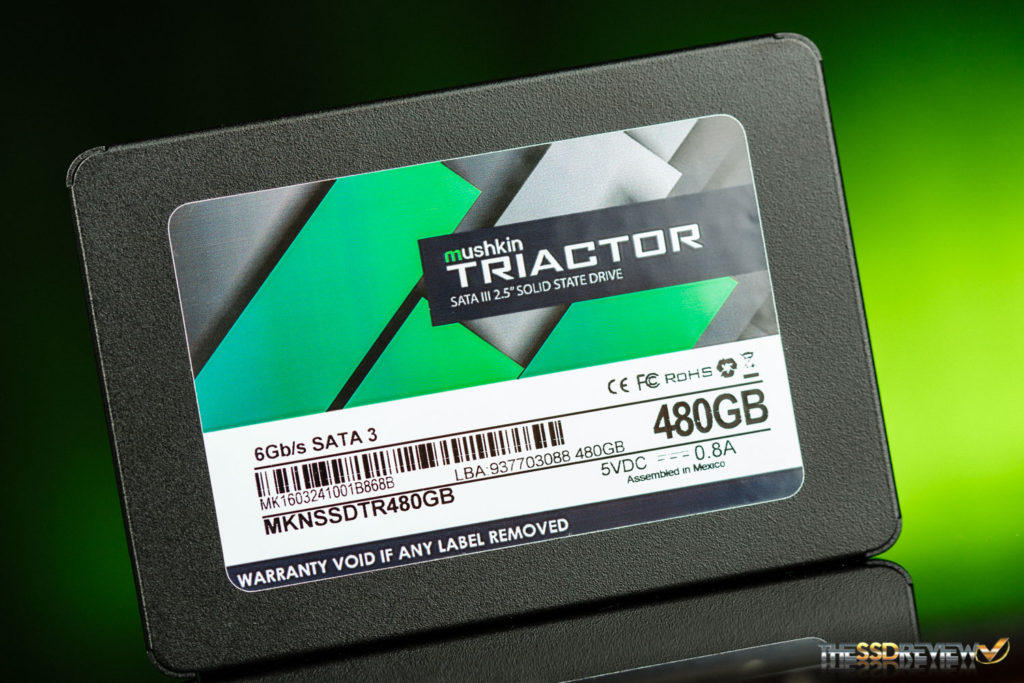Back in 2014 we took a good look at the Mushkin Reactor. At the time, it was the best value 1TB SSD you could buy. You could even argue that it was THE SSD which made high value, high capacity SSDs the norm. Now, Mushkin is trying to take value a step farther by introducing a cheaper alternative into the market. Instead of MLC NAND this time around, they’ve opted to utilize SanDisk’s TLC NAND and Silicon Motion’s SM2256 controller in the new Mushkin Triactor.
This barebone, TLC packed SSD, is their latest answer to the demand for more affordable, high capacity SSDs by the consumer market. Promising to deliver the lightning fast boot and application load times that HDDs just can’t, this SSD just may be a viable option for those of you who have yet to make the move to flash.

We’ve tested quite a few TLC based SSDs as of late, will the Mushkin Triactor show up the competition? Or will it lag behind in all its TLC “glory?” So far all we can say is that it sure does look cool. Read on as we analyze the new Mushkin Triactor 480GB in today’s review!
SPECIFICATIONS, PRICING, AND AVAILABILITY
The Mushkin Triactor is a SATA 6Gb/s SSD that comes in a 2.5″ 7mm form factor. Mushkin’s marketing material states it is available in capacities of 120GB-960GB, however, Amazon currently lists the 240GB ($63) and 480GB ($110) models only. Sequential speeds are rated for up to 560 MB/s read and 515 MB/s write. Random read and write performance is listed for up to 85K/87K IOPS. Endurance figures are not listed. In addition, the MTBF rating is 2 million hours and it is covered by a 3-year warranty.
Features wise, the Mushkin Triactor supports TRIM, DevSleep, and SMART monitoring. Data protection is provided by their Mushkin Enhanced Data-Protection Suite (M.E.D.S). It utilizes internal flash array parity and LDPC ECC to increase data reliability and endurance. As well, data shaping algorithms and global wear leveling also increase endurance. StaticDataRefresh and early weak block retirement ensure strong blocks remain in use and helps to ensure data integrity. Finally, it utilizes a caching architecture that operates some TLC as SLC to provide for fast burst write performance.
PACKAGING AND COMPONENTS
The SSD ships in an easy to open plastic case that can be hung on a shelf. The SSD is visible on the front side and the main selling points are stated on the back. The green and black/steal, abstract graphical design of the SSD and packaging is quite appealing. The SSD case is all metal and weighs in at 58g and is held together by four small metal screws on the sides.
Once disassembled we can see a total of 16 NAND packages, a single DRAM package, and controller on a full sized PCB. There is a thermal pad attached to the controller too distribute heat into the case as well.

The NAND is by SanDisk, it is 1znm 256Gbit TLC NAND flash and each package is 32GB in capacity. Once formatted in Windows there is about 446GB usable capacity. The cache provided by a Nanya 512MB LPDDR3 1600 DRAM package and the controller is by Silicon Motion, the SM2256K. This is a low cost-oriented controller, so as we benchmark, we shouldn’t expect the best performance out, but reasonable performance for most consumer workloads. Let’s move on and get to testing!
 The SSD Review The Worlds Dedicated SSD Education and Review Resource |
The SSD Review The Worlds Dedicated SSD Education and Review Resource | 
Wait, does are 256Gbit dies or just two 128Gbit dies stacked on top of eachother ?
The big problem with their (Mushkin) drives is there is no software that comes with the drive so I can upgrade from my HDD. I have to go find something to clone my drive with that I can trust then find another trustworthy download to maintain my drive with then there is no way to update the firmware when needed that I know of. Not a complete package so I went with OCZ.
Who cares. Plenty of free cloning software if you use something called Google.
SanDisk DOES NOT manufacture 1nm chips, please edit your article, page 1. : “1znm” does NOT exist.
I’m curious if this would work well as a secondary drive for the XBox One. It seems like it’s be fairly slow getting games loaded onto it at first, but after that, do you think it’d offer better load times than the stock Xbox drive?